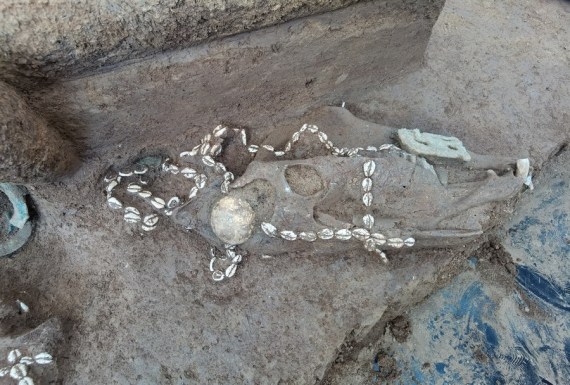China
တရုတ်နိုင်ငံ အလယ်ပိုင်းတွင် နှစ်ပေါင်း ၃၀၀၀ သက်တမ်းရှိ မျိုးနွယ်စုသုသာန်အား ဖော်ထုတ်တွေ့ရှိ

ကျိန့်ကျိုး၊ ဇန်နဝါရီ ၆ ရက် (ဆင်ဟွာ)
ရှန်မင်းဆက်အုပ်စိုးသော (ဘီစီ ၁၀၄၆-၁၆၀၀) ၏ နှောင်းပိုင်းကာလမှ ဖြစ်သော အုတ်ဂူအများအပြားစုဝေးနေသည့် ကြီးမားသော သင်္ချိုင်းကြီးအား တရုတ်နိုင်ငံ အလယ်ပိုင်း ဟဲနန်ပြည်နယ် Anyang မြို့တွင် မကြာသေးမီက ရှာဖွေတွေ့ရှိခဲ့ကြောင်း မြို့၏ ယဉ်ကျေးမှုအမွေအနှစ်များနှင့် ရှေးဟောင်းသုတေသနဌာနမှ သိရသည်။
ယူနက်စကိုကမ္ဘာ့အမွေအနှစ်နေရာဖြစ်သည့် Yin Ruins ၏ နန်းတော်နှင့် ရှေးဟောင်းဘုရားကျောင်းမှ၂.၄ ကီလိုမီတာအကွာတွင် တည်ရှိသော Shaojiapeng ရှေးဟောင်းအမွေအနှစ်နေရာသည် ရှန် မင်းဆက်လက်ထက် “Ce” မျိုးနွယ်စုအတွက် အဓိကနေထိုင်ရာ နေရာတစ်ခုဟု ယူဆရကြောင်း သိရသည်။
သင်္ချိုင်းဂူဘုရားတွင် တူးဖော်တွေ့ရှိရသော ကြေးထည်ပစ္စည်းများ၊ ကမ္ပည်းပြားများပေါ်တွင် မျိုးနွယ်စု၏ လက္ခဏာကို ညွှန်ပြသည့် သင်္ကေတတစ်ခု ဖြစ်သော တရုတ်အက္ခရာ “Ce” ကို တွေ့ရှိခဲ့ရခြင်းဖြစ်သည်။
အဆောက်အအုံအုတ်မြစ် ၁၈ ခု၊ သင်္ချိုင်း ၂၄ ခု၊ မြင်းရထားတွင်း ၄ တွင်း၊ လက်ရာမြောက်သော ကြေးထည်ပစ္စည်းများ၊ ကျောက်စိမ်းနှင့် ကျောက်မျက်ရတနာများ၊ အရိုးထည်နှင့် ယောက်သွား အပါအဝင် ရှေးဟောင်းပစ္စည်းများအား အဆိုပါ နေရာကို ၂ နှစ်ကြာ တူးဖော်မှုအတွင်း တွေ့ရှိခဲ့ရသည်။
လူသေများနှင့်အတူ မြှုပ်နှံထားသော မြင်းရထားတွဲခြောက်စီးနှင့် မြင်းစီးသူရဲအများအပြားကို တွင်းများအတွင်း တန်ဖိုးကြီးသော အလှဆင်မှုများဖြင့် တူးဖော်တွေ့ရှိခဲ့ကြောင်း သိရသည်။ အချို့သော စစ်သည်များသည် ခရုခွံကြိုးများဖြင့် ဦးထုပ်များ ဝတ်ဆင်ထားပြီး အချို့သော မြင်းများ၏ နဖူးများကို ရွှေမှုန်ကြဲထားသော ကြေးဝါဖြင့် အလှဆင်ထားသည်ကို တွေ့ရှိရကြောင်း သိရသည်။
“ရထားပိုင်ရှင်ရဲ့ ထူးခြားတဲ့ အဆင့်အတန်းနဲ့ အင်အားကို ထင်ဟပ်စေတဲ့ Anyang ရဲ့ ရှေးဟောင်းရှာဖွေတွေ့ရှိမှုတွေထဲမှာ ဒါဟာ အလွန်ရှားပါးပါတယ်” ဟု ၎င်းရှေးဟောင်းရှာဖွေရေး အင်စတီကျူ့မှ ဒါရိုက်တာ Kong Deming က ပြောကြားခဲ့သည်။
သုတေသီများသည် မျိုးနွယ်စု၏ လူနေမှုအဆင့်အတန်း၊ ၎င်းတို့၏ လုပ်ငန်းတာဝန်ခွဲဝေမှုနှင့် ရှန်တော်ဝင်မိသားစုနှင့် ဆက်ဆံရေး အပါအဝင်၎င်းယဉ်ကျေးမှုနေရာ၌ ကျန်နက်နဲသောအရာများကို ဆက်လက်တူးဖော်ရန် လုပ်ဆောင်နေဆဲဖြစ်ကြောင်း သိရသည်။
ထိုနေရာရှိ ရုပ်ကြွင်းများသည် ကွဲပြားပြီး အတော်အတန် ကောင်းမွန်စွာ ထိန်းသိမ်းထားသောကြောင့် ယင် (Yin )အပျက်အစီးများ၏ အတိုင်းအတာနှင့် အသွင်အပြင်ကို လေ့လာရန် အလွန်အရေးကြီးကြောင်း Kong ၏ ပြောကြားချက်အရ သိရသည်။ (Xinhua)
………………………………….
(English Version)
3,000-year-old clan cemetery uncovered in central China
ZHENGZHOU, Jan. 6 (Xinhua) — A large-scale tomb cluster dating back to the late Shang Dynasty (1600-1046 BC) was recently discovered in Shaojiapeng Village, Anyang City of central China’s Henan Province, according to the city’s institute of cultural relics and archaeology.
Located 2.4 km away from the palace and ancestral temple of the Yin Ruins, a UNESCO World Heritage site, the Shaojiapeng site is believed to be a major living area for a clan named “Ce” in the Shang Dynasty.
The Chinese character “Ce” was found on the inscription of bronzeware uncovered in the cemetery relics, which indicates the identity of the clan.
A total of 18 building foundations, 24 tombs, four horse and chariot pits, along with relics including exquisite bronzeware, jade and stone objects, bone ware and mussels, were found during the two-year excavation of the site.
Six carriages and several warriors and horses buried with the dead were uncovered in the pits, with luxurious decorations on the relics. Some warriors were found wearing hats with shell strings and the foreheads of some horses were decorated with gold veneer and bronze backing.
“This is very rare among the ancient discoveries of Anyang, reflecting the extraordinary status and power of the carriage owner,” said Kong Deming, director of the institute.
The researchers are still working on unlocking the remaining mysteries of the site, including the social status of the clan, their division of labor and their relationship with the Shang royal family.
The relics at the site are diverse and relatively well-preserved, making them of great significance to studies on the scope and layout of the Yin Ruins, according to Kong. Enditem






